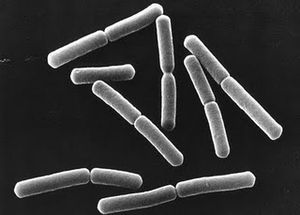Candidatus Accumulibacter Phosphatis: Difference between revisions
No edit summary |
No edit summary |
||
| Line 1: | Line 1: | ||
==PAGE UNDER CONSTRUCTION== | |||
Bacteria | ==Classification== | ||
Kingdom: Bacteria | |||
Phylum: Proteobacteria | |||
Class: Betaproteobacteria | |||
Order: unclassified Betaproteobacteria | |||
Family: Candidatus Accumulibacter | |||
===Species=== | |||
''Candidatus Accumulibacter phosphatis'' | |||
NCBI Taxonomy ID: 522306 | NCBI Taxonomy ID: 522306 | ||
Sub Groups: | |||
==Description and Significance== | |||
[[File:P. Cloroaphis.jpg|thumb|''Pseudomonas chlororaphis'']] | |||
Describe the appearance, habitat, etc. of the organism, and why you think it is important. | Describe the appearance, habitat, etc. of the organism, and why you think it is important. | ||
Genome Structure | |||
==Genome Structure== | |||
Describe the size and content of the genome. How many chromosomes? Circular or linear? Other interesting features? What is known about its sequence? | Describe the size and content of the genome. How many chromosomes? Circular or linear? Other interesting features? What is known about its sequence? | ||
==Cell Structure, Metabolism and Life Cycle== | |||
Cell Structure, Metabolism and Life Cycle | |||
Interesting features of cell structure; how it gains energy; what important molecules it produces. | Interesting features of cell structure; how it gains energy; what important molecules it produces. | ||
==Ecology and Pathogenesis== | |||
Ecology and Pathogenesis | |||
Habitat; symbiosis; biogeochemical significance; contributions to environment. | Habitat; symbiosis; biogeochemical significance; contributions to environment. | ||
If relevant, how does this organism cause disease? Human, animal, plant hosts? Virulence factors, as well as patient symptoms. | If relevant, how does this organism cause disease? Human, animal, plant hosts? Virulence factors, as well as patient symptoms. | ||
References | ==References== | ||
[Sample reference] [http://ijs.sgmjournals.org/cgi/reprint/50/2/489 Takai, K., Sugai, A., Itoh, T., and Horikoshi, K. "''Palaeococcus ferrophilus'' gen. nov., sp. nov., a barophilic, hyperthermophilic archaeon from a deep-sea hydrothermal vent chimney". ''International Journal of Systematic and Evolutionary Microbiology''. 2000. Volume 50. p. 489-500.] | |||
[Sample reference] Takai, K., Sugai, A., Itoh, T., and Horikoshi, K. "Palaeococcus ferrophilus gen. nov., sp. nov., a barophilic, hyperthermophilic archaeon from a deep-sea hydrothermal vent chimney". International Journal of Systematic and Evolutionary Microbiology. 2000. Volume 50. p. 489-500. | |||
Page authored by Johanna Kinster and Kevin Koryto, students of Prof. Jay Lennon at Michigan State University. | ==Author== | ||
Page authored by Johanna Kinster and Kevin Koryto, students of Prof. Jay Lennon [http://www.kbs.msu.edu/faculty/lennon/ Prof. Jay Lennon] at Michigan State University. | |||
[[Category:Pages edited by students of Jay Lennon at Michigan State University]] | |||
Revision as of 11:19, 22 April 2010
PAGE UNDER CONSTRUCTION
Classification
Kingdom: Bacteria
Phylum: Proteobacteria
Class: Betaproteobacteria
Order: unclassified Betaproteobacteria
Family: Candidatus Accumulibacter
Species
Candidatus Accumulibacter phosphatis
NCBI Taxonomy ID: 522306 Sub Groups:
Description and Significance
Describe the appearance, habitat, etc. of the organism, and why you think it is important.
Genome Structure
Describe the size and content of the genome. How many chromosomes? Circular or linear? Other interesting features? What is known about its sequence?
Cell Structure, Metabolism and Life Cycle
Interesting features of cell structure; how it gains energy; what important molecules it produces.
Ecology and Pathogenesis
Habitat; symbiosis; biogeochemical significance; contributions to environment. If relevant, how does this organism cause disease? Human, animal, plant hosts? Virulence factors, as well as patient symptoms.
References
Author
Page authored by Johanna Kinster and Kevin Koryto, students of Prof. Jay Lennon Prof. Jay Lennon at Michigan State University.

